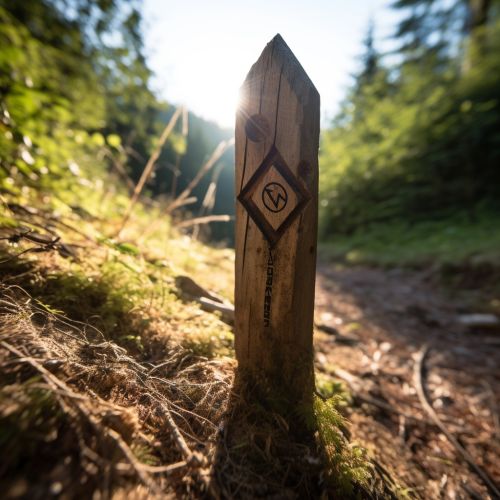Waymark
Introduction
A waymark is a term used in hiking, backpacking, mountaineering, and other outdoor activities to refer to a sign, symbol or landmark that indicates the direction and/or distance on a trail. Waymarking is the process of placing these signs along a trail. The practice has a long history, with roots in ancient civilizations, and has evolved with advancements in technology and changes in societal norms.
History
The practice of waymarking has been traced back to ancient times. The Romans, for instance, used stone pillars known as milestones to mark distances on their roadways. These markers were typically placed at intervals of one Roman mile (approximately 1.6 kilometers), and often included information about the distance to the nearest town or city, as well as the name of the road's builder.
In the Middle Ages, pilgrims traveling on foot to religious sites often followed routes marked by symbols or landmarks. One of the most famous of these routes is the Camino de Santiago, a network of pilgrimage routes leading to the cathedral of Santiago de Compostela in Spain. The route is marked by yellow arrows and the symbol of the scallop shell.
In the 19th century, as recreational hiking became popular, organizations such as the Appalachian Mountain Club in the United States began marking trails with painted blazes or carved notches on trees. This practice continues today, with many long-distance trails, including the Appalachian Trail and the Pacific Crest Trail, marked in this way.


Types of Waymarks
There are many different types of waymarks, ranging from simple painted marks or carvings on trees, to elaborate signs and plaques. The type of waymark used often depends on the nature of the trail and the organization responsible for its maintenance.
Painted Blazes
Painted blazes are perhaps the most common type of waymark. They are typically small, rectangular patches of paint applied to trees or rocks along the trail. The color of the blaze often corresponds to a specific trail, with maps and guidebooks indicating which color corresponds to which trail.
Cairns
Cairns, or piles of rocks, are another common type of waymark, particularly in areas where there are few trees, such as above the tree line on mountains or in desert regions. Cairns can range from simple piles of stones to elaborate stacks, and are often built and maintained by hikers.
Signs and Plaques
In some areas, particularly in parks or protected areas, trails may be marked with signs or plaques. These can provide a wealth of information, including the name of the trail, the distance to certain landmarks, and even maps or other navigational aids.
Digital Waymarks
With the advent of GPS technology, digital waymarks have become increasingly common. These are coordinates that can be downloaded to a GPS device or smartphone, and used to navigate the trail. Digital waymarks are particularly useful on trails that are not well-marked, or in areas where the physical waymarks may be covered by snow or other natural elements.
Importance of Waymarking
Waymarking plays a crucial role in outdoor activities. It helps to guide hikers and other outdoor enthusiasts along trails, preventing them from getting lost. Waymarks can also provide important information, such as the distance to the next landmark or the difficulty level of the trail.
In addition to their practical benefits, waymarks also have cultural and historical significance. They can serve as reminders of the people who have traveled the trail before, and can contribute to the sense of adventure and discovery that comes with exploring the outdoors.
Waymarking and Conservation
Waymarking is closely tied to conservation efforts. By clearly marking trails, waymarks can help to minimize the impact of hiking and other outdoor activities on the environment. They guide hikers along established paths, reducing the risk of erosion and damage to vegetation.
Furthermore, waymarks can also be used to convey messages about conservation. For instance, they can provide information about the local flora and fauna, encourage hikers to follow Leave No Trace principles, or remind hikers to stay on the trail to protect sensitive habitats.
